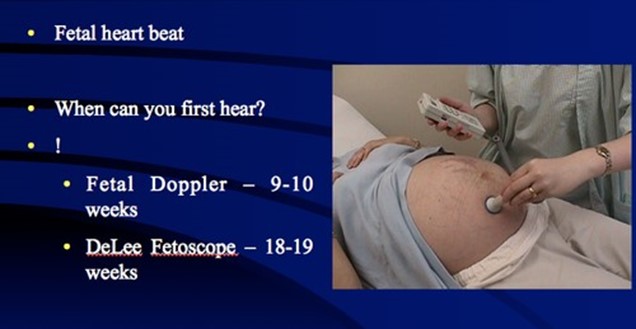A nurse is preparing to assess fetal heart tones for a client who is at 12 weeks of gestation.
Which of the following actions should the nurse take?
Position the ultrasound stethoscope above the symphysis pubis to assess the fetal heart rate.
Measure the fundal height to determine the placement of the ultrasound stethoscope.
Place the client in a side-lying position prior to assessing the fetal heart rate.
Perform Leopold maneuvers prior to auscultating the fetal heart rate.
The Correct Answer is A

Nursing Test Bank
Naxlex Comprehensive Predictor Exams
Related Questions
Correct Answer is {"dropdown-group-1":"B","dropdown-group-2":"B"}
Explanation
safety followed by the client’s pain.
The nurse should first address the client’s safety because it is the most basic and essential need according to Maslow’s hierarchy of needs. The client may be at risk of abuse or neglect from his adult child, as evidenced by the bruises, body odor, unclean clothes, low BMI, and submissive behavior. The nurse should assess the client for signs of physical or emotional abuse and report any suspicions to the appropriate authorities. The nurse should also provide a safe and supportive environment for the client and encourage him to express his feelings and concerns.
The nurse should then address the client’s pain because it is a physiological need that affects the client’s comfort and well-being. The client rates his pain as 8 on a 0 to 10 scale and is not moving his right arm. The nurse should assess the client’s arm for signs of injury, such as swelling, deformity, or bleeding. The nurse should also administer analgesics as prescribed and monitor the client’s response to pain relief. The nurse should also provide non-pharmacological interventions, such as ice packs, elevation, or distraction.
The other choices are less urgent than safety and pain. The client’s abrasions are superficial and do not pose a significant risk of infection or bleeding. The client’s hygiene is important but not a priority at this time. The client’s BMI indicates that he is underweight, but this is a chronic condition that requires long-term nutritional intervention. The client’s heart rate is slightly elevated but not alarming, and may be due to pain, anxiety, or dehydration.
Correct Answer is B
Explanation
The correct answer is choice B. Fish. Fish is a good source of protein and omega-3 fatty acids, which can help lower blood pressure, reduce inflammation, and prevent blood clots. Fish is also low in sodium, which is important for people with hypertension, as excess sodium can raise blood pressure by retaining fluid in the body. Fish is part of the DASH diet, which stands for Dietary Approaches to Stop Hypertension, and is a healthy eating plan that emphasizes fruits, vegetables, whole grains, low-fat dairy, nuts, seeds, legumes, and lean meats.
Choice A. Cheese is wrong because cheese is high in sodium and saturated fat, which can increase blood pressure and cholesterol levels.
Cheese should be limited or avoided by people with hypertension.
Choice C. Red meat is wrong because red meat is also high in sodium and saturated fat, as well as cholesterol, which can contribute to hypertension and heart disease.
Red meat should be eaten sparingly or replaced by leaner sources of protein like fish, poultry, or beans.
Choice D. Canned black beans are wrong because canned black beans are high in sodium, as most canned foods are preserved with salt. Canned black beans should be rinsed well before eating or replaced by dried or cooked black beans, which are lower in sodium and high in fiber, potassium, magnesium, and calcium, which are beneficial for blood pressure control.
Whether you are a student looking to ace your exams or a practicing nurse seeking to enhance your expertise , our nursing education contents will empower you with the confidence and competence to make a difference in the lives of patients and become a respected leader in the healthcare field.
Visit Naxlex, invest in your future and unlock endless possibilities with our unparalleled nursing education contents today
Report Wrong Answer on the Current Question
Do you disagree with the answer? If yes, what is your expected answer? Explain.
Kindly be descriptive with the issue you are facing.
